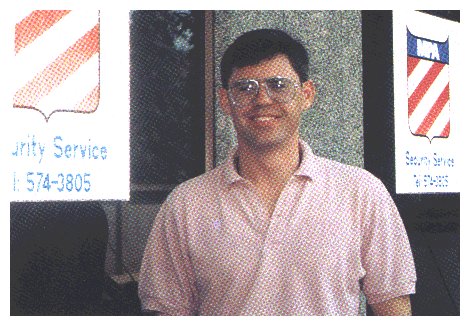DEARMING THE LIMB TAKERS
Story and Photograph by

Thirty-two-year-old Darren "Jay" Steed is an explosives ordnance expert (EOD). The Blackfoot, Idaho, native honed his skills in the U.S. military before setting out to clear mines in wartorn countries such as Cambodia. Steed says his job is, "inherently dangerous (would you want it?), and it has its grim points to it, but the military has instituted certain programs to make it relatively safe."
With the POW-MIA Remains Recovery, Joint Task Force Full Accounting (JTF-FA) Program Steed made six or seven MIA missions to Laos, one to Northern Vietnam, and a couple to Cambodia. This program was supported by CILHI (Central Identification Laboratory- Hawaii).
In 1993, Steed was on the team that located the sites of four complete sets of remains of four journalists missing in Cambodia since 1975. They were positively identified by CILHI. The journalists had been beaten to death.

Jay Steed
Asked about the criteria for conducting a search for POW-MIA remains Steed says, "Villagers will report a crash site, and then investigators will go out and check it out to see if it is a feasible site. If it is, we will then perform a survey, which we usually organize while we are already working on a known site. If evidence is found during the survey then an excavation is conducted to recover and repatriate remains. We once positively identified a guy over a single tooth (the tooth was later given a full dress burial.)"
Describing how an area is cleared of mines Steed says, "First, we find an area that is determined to be mined, then we set up a clearance operation, divide into teams (marking, EOD and controlling) and determine lanes of travel, which are usually one meter wide. Using metal detectors and probing we then start to clear the land. Anything you find you mark, and then you pull back and rest. The disposal teams then go and place the explosives on the mines and detonate them, and then we go back to check the area again to make sure that it is clear. The work requires intense concentration so you can't do it for a long period of time without resting.
When we are clearing we move at a steady rate in a straight line with the sweepers or locators in front (in this case the Cambodians) who locate the ordinance and mark it. You wear a flak vest (to keep your body in tact), a helmet, safety goggles and you are supposed to wear gloves as well, but when you are working on the item especially if its a mine you want to work freehanded because you want to know if there are any trip wires. There isn't any protection for your legs because you are usually stooped over or kneeling down anyway.
"You go out for about thirty minutes at a time. You can either spend the entire day marking and do the disposal at night, or dispose of the ordnance as you go along. It depends on the controller. You can blow up as many as several hundred mines a day. It all depends on if you can you move them, and if is it safe to do that. The EOD technician must determine if the ordnance can be moved into one area for one easy shot destruction, or if you must dispose of it on site.
"One thing you find in Indochina are items that you have never seen before. You are not sure what country the ordinance is from, or what's inside in it? It may even be a piece of ordnance you know but they are delivering or emplacing it a different way. The EOD training teaches you identification techniques and it's really all a process of elimination. In Vietnam the stuff is time sensitive (and had been emplaced for over twenty years) whereas in Cambodia they are not usually booby trapping the ordnance with tripwires, just laying it.
"A lot of innocent farmers have land that is contaminated with ordnance, and they can't utilize their lands so they can't grow rice to feed their families. They need help in clearing their land.
"Mines are very hard to detect. They are making them out of wood and plastic now so you can't use a metal detector to find them. It can take forever to locate them by probing.
"When you are probing you have to get on line, kneel down on the ground, and then you take a nonmetallic rod, with a sharp end (like a pencil), stick it into the ground an inch or two and when you hit something you have to dig it up a little and identify it. It can take forever to clear a fifty meter patch. For low magnetic mines, or minimum metal mines (a type 72, or a VS 50), only one metal detector can detect these, and this is the Forester metal detector but it costs about $US 6,000 apiece. It's very expensive. And companies aren't willing to fork out that much."
In reflecting on the ordnance that the USA dropped on Indochina Steed says, "We dropped about 360,000 tonnes of bombs on Indochina, but we dropped over half of those bombs on Laos. We dropped more bombs on South Vietnam than we did on North Vietnam. We were fighting the North Vietnamese but they were the least bombed country. We dropped all that ordnance so theoretically it should be our responsibility to help clean it up."
Steed is currently working with MPA International (a firm that also provides VIP protection) on commercial contracting clearing areas for construction and mining companies. In a country that still is littered with ten million mines he has his work cut out for him.
For further info contact Jay Steed c/o:
Advisor Mine Clearing Operations
Bldg #31, Corner of Streets 178 & 63
Kahn Daun Penh, Phnom Penh
Cambodia
Tel: (885-23) 362902
Fax: (855-23) 362901
Mobil: (855-12) 804991